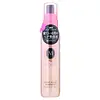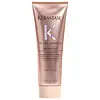What's inside
What's inside
 Key Ingredients
Key Ingredients

 Benefits
Benefits

 Concerns
Concerns

 Ingredients Side-by-side
Ingredients Side-by-side

Water
Skin ConditioningDipropylene Glycol
HumectantGlycerin
HumectantDimethicone
EmollientCetearyl Alcohol
EmollientPEG-60 Hydrogenated Castor Oil
EmulsifyingBehentrimonium Chloride
PreservativeAminopropyl Dimethicone
Lactic Acid
BufferingStearyl Dihydroxypropyldimonium Oligosaccharides
Arginine
MaskingHydroxyethyl Urea
HumectantSteartrimonium Chloride
PreservativeHoney
HumectantSodium Hyaluronate
HumectantHydrolyzed Conchiolin Protein
Skin ConditioningCetyl Ethylhexanoate
EmollientIsopropyl Alcohol
SolventStearyl Pg-Dimethylamine
Isoceteth-10
EmulsifyingPropylene Glycol
HumectantStearyl Alcohol
EmollientDisodium EDTA
Ammonium Lactate
BufferingButylene Glycol
HumectantSodium Carbonate
BufferingWater, Dipropylene Glycol, Glycerin, Dimethicone, Cetearyl Alcohol, PEG-60 Hydrogenated Castor Oil, Behentrimonium Chloride, Aminopropyl Dimethicone, Lactic Acid, Stearyl Dihydroxypropyldimonium Oligosaccharides, Arginine, Hydroxyethyl Urea, Steartrimonium Chloride, Honey, Sodium Hyaluronate, Hydrolyzed Conchiolin Protein, Cetyl Ethylhexanoate, Isopropyl Alcohol, Stearyl Pg-Dimethylamine, Isoceteth-10, Propylene Glycol, Stearyl Alcohol, Disodium EDTA, Ammonium Lactate, Butylene Glycol, Sodium Carbonate
Water
Skin ConditioningCetearyl Alcohol
EmollientCocamidopropyl Betaine
CleansingBehentrimonium Chloride
PreservativePropylene Glycol
HumectantAmodimethicone
Parfum
MaskingIsopropyl Alcohol
SolventSodium Chloride
MaskingPhenoxyethanol
PreservativeHydroxypropyl Guar
Emulsion StabilisingEthanolamine
BufferingPolyquaternium-37
Limonene
PerfumingCaprylyl Glycol
EmollientPropylene Glycol Dicaprylate/Dicaprate
EmollientCocos Nucifera Oil
MaskingTrideceth-6
EmulsifyingPPG-1 Trideceth-6
Skin ConditioningLinalool
PerfumingCitronellol
PerfumingCetrimonium Chloride
AntimicrobialAcrylates/Stearyl Methacrylate Copolymer
Emulsion StabilisingSorbitan Oleate
EmulsifyingSodium Hyaluronate
HumectantCaprylic/Capric Triglyceride
MaskingLactic Acid
BufferingHexyl Cinnamal
PerfumingAlpha-Isomethyl Ionone
PerfumingGlycolic Acid
BufferingCitric Acid
BufferingEDTA
Rosa Canina Flower Extract
AstringentWater, Cetearyl Alcohol, Cocamidopropyl Betaine, Behentrimonium Chloride, Propylene Glycol, Amodimethicone, Parfum, Isopropyl Alcohol, Sodium Chloride, Phenoxyethanol, Hydroxypropyl Guar, Ethanolamine, Polyquaternium-37, Limonene, Caprylyl Glycol, Propylene Glycol Dicaprylate/Dicaprate, Cocos Nucifera Oil, Trideceth-6, PPG-1 Trideceth-6, Linalool, Citronellol, Cetrimonium Chloride, Acrylates/Stearyl Methacrylate Copolymer, Sorbitan Oleate, Sodium Hyaluronate, Caprylic/Capric Triglyceride, Lactic Acid, Hexyl Cinnamal, Alpha-Isomethyl Ionone, Glycolic Acid, Citric Acid, EDTA, Rosa Canina Flower Extract
 Reviews
Reviews

Alternatives
Ingredients Explained
These ingredients are found in both products.
Ingredients higher up in an ingredient list are typically present in a larger amount.
This ingredient is a preservative and often used for it's anti-static properties. You'll most likely see this ingredient in hair conditioners.
It does not cause irritation or sensitization in leave-on products at 1-5%.
Cetearyl alcohol is a mixture of two fatty alcohols: cetyl alcohol and stearyl alcohol. It is mainly used as an emulsifier. Emulsifiers help prevent the separation of oils and products. Due to its composition, it can also be used to thicken a product or help create foam.
Cetearyl alcohol is an emollient. Emollients help soothe and hydrate the skin by trapping moisture.
Studies show Cetearyl alcohol is non-toxic and non-irritating. The FDA allows products labeled "alcohol-free" to have fatty alcohols.
This ingredient is usually derived from plant oils such as palm, vegetable, or coconut oils. There is debate on whether this ingredient will cause acne.
Due to the fatty acid base, this ingredient may not be Malassezia folliculitis safe.
Learn more about Cetearyl AlcoholIsopropyl Alcohol is more commonly known as rubbing alcohol. It is most commonly used as a solvent, meaning it helps other ingredients dissolve.
This ingredient is an astringent alcohol. Astringent alcohols may also irritate skin as they high amounts may strip away your skin's natural oils.
Other types of astringent alcohols include:
According to the National Rosacea Society based in the US, you should be mindful of products with these alcohols in the top half of ingredients.
Any type of sanitizing product will have high amounts of alcohol to help kill bacteria and viruses.
Learn more about Isopropyl AlcoholLactic Acid is another well-loved alpha hydroxy acid (AHA). It is gentler than glycolic acid but still highly effective.
Its main role is to exfoliate the surface of the skin by loosening the “glue” that holds dead skin cells together. Shedding those old cells leads to smoother, softer, and more even-toned skin.
Because lactic acid molecules are larger than glycolic acid, they don’t penetrate as deeply. This means they’re less likely to sting or irritate, making it a great choice for beginners or those with sensitive skin.
Like glycolic acid, it can:
Lactic acid also acts as a humectant (like hyaluronic acid). It can draw water into the skin to improve hydration and also plays a role in the skin's natural moisturizing factor (NMF) in the form of sodium lactate.
Studies show it can boost ceramide production to strengthen the skin barrier and even help balance the skin’s microbiome.
To get results, choose products with a pH between 3-4.
Lower strengths (5-12%) focus on surface exfoliation; higher strengths (12% and up) can reach deeper in the dermis (deeper, supportive layer) to improve skin texture and firmness over time.
Though it was originally derived from milk, most modern lactic acid used in skincare is vegan. It is made through non-dairy fermentation to create a bio-identical and stable form suitable for all formulations.
When lactic acid shows up near the end of an ingredient list, it usually means the brand added just a tiny amount to adjust the product’s pH.
Legend has it that Cleopatra used to bathe in sour milk to help reduce wrinkles.
Lactic acid is truly a gentle multitasker: it exfoliates, hydrates, strengthens, and brightens. It's a great ingredient for giving your skin a smooth, glowing, and healthy look without the harshness of stronger acids.
Read more about some other popular AHA's here:
Learn more about Lactic AcidPropylene Glycol is an odorless, colorless liquid. As a humectant, it helps skin retain moisture. It also aids in delivering active ingredients.
Another role of this ingredient is preventing a product from melting or freezing. Propylene glycol also adds antimicrobrial properties to a product, elongating product lifespan.
This ingredient is considered an organic alcohol and commonly added into both cosmetics and foods.
Those with sensitive skin or conditions may develop a rash when using this ingredient.
Learn more about Propylene GlycolSodium Hyaluronate is hyaluronic acid's salt form. It is commonly derived from the sodium salt of hyaluronic acid.
Like hyaluronic acid, it is great at holding water and acts as a humectant. This makes it a great skin hydrating ingredient.
Sodium Hyaluronate is naturally occurring in our bodies and is mostly found in eye fluid and joints.
These are some other common types of Hyaluronic Acid:
Learn more about Sodium HyaluronateWater. It's the most common cosmetic ingredient of all. You'll usually see it at the top of ingredient lists, meaning that it makes up the largest part of the product.
So why is it so popular? Water most often acts as a solvent - this means that it helps dissolve other ingredients into the formulation.
You'll also recognize water as that liquid we all need to stay alive. If you see this, drink a glass of water. Stay hydrated!
Learn more about Water